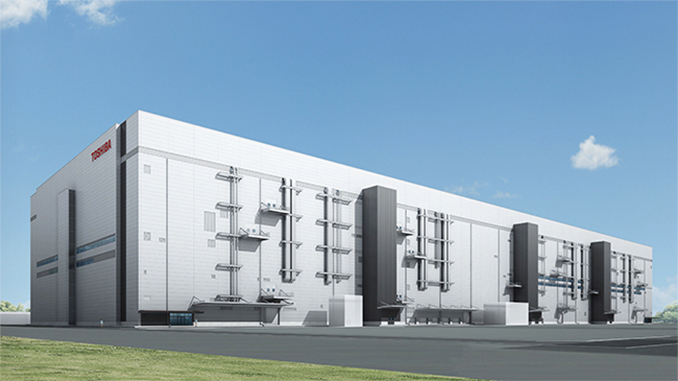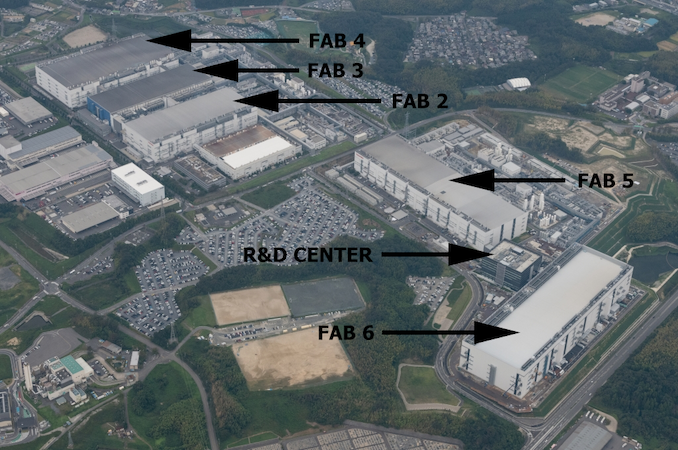Toshiba & WD NAND Production Hit By Power Outage: 6 Exabytes Lost
by Anton Shilov on June 28, 2019 12:15 PM EST
Toshiba Memory and Western Digital on Friday disclosed that an unexpected power outage in the Yokkaichi province in Japan on June 15 affected the manufacturing facilities that are jointly operated. Right now, production facilities are partially halted and they are expected to resume operations only by mid-July.
Western Digital says that the 13-minute power outage impacted wafers that were processed, the facilities, and production equipment. The company indicates that the incident will reduce its NAND flash wafer supply in Q3 by approximately 6 EB (exabytes), which is believed to be about a half of the company’s quarterly supply of NAND. Toshiba does not disclose the impact the outage will have on its NAND wafer supply in the coming months, but confirms that the fabs are partially suspended at the moment. Keeping in mind that Toshiba generally uses more capacity of the fabs than WD, the impact on its supply could be significantly higher than 6 EB with some estimating that it could be as high as ~9 EB.
Both companies are assessing the damage at the moment, so the financial harm of the incident is unclear. Not even counting potential damage to production tools and other equipment used at the fabs, 6 EB of NAND cost a lot of money. Furthermore, analysts from TrendForce believe that a consequence of the outage will be some loss of confidence from clients of both companies, which will have a financial impact as well.
The Yokkaichi Operations campus jointly owned and run by Toshiba and Western Digital produces about 35% of the global NAND output in terms of revenue, according to TrendForce. At present, the manufacturing base has five production facilities (Fab 2, Fab 3, Fab 4, Fab 5, and Fab 6) as well as an R&D center, all of which were affected by the outage. Three fabs within the campus produce 3D NAND flash, whereas another two are used to make special-purpose types of memory.
Considering the gargantuan size of the Yokkaichi Operations, disruptions of its supply will inevitably have an effect on 2D NAND and 3D NAND spot prices in the short-term future. Nonetheless, since contract prices have already been set for Q3 (and possibly Q4), they are not going to change. Meanwhile, it remains to be seen whether large customers will have to go shopping in Q3 or Q4 and affect prices on the spot markets further.
Considering that the Yokkaichi Operations produces at least 1/3 of the global NAND flash output (let’s assume that dollar share more or less corresponds to bit share) and half of its production for the quarter was lost because of the incident, this means that the industry will miss approximately 1/6 (or 16.5%) of the global NAND supply in Q3. Whether or not this will create a deficit on the market that will cause significant price hikes depends on multiple factors and is something that remains to be seen.
Related Reading
- Toshiba Memory and Western Digital Open Fab 6 and New Memory R&D Center
- Toshiba Memory & Western Digital Finalize Fab K1 Investment Agreement
- Toshiba Begins to Construct New BiCS 3D NAND Fab in Iwate Prefecture
- Toshiba Memory to Build New Fab to Produce BiCS 3D NAND
- Toshiba Finalizes Plans for New 3D NAND Fab: Coming Online in 2019
- Toshiba to Build New Fab to Produce BiCS NAND Flash
Sources: Western Digital, Reuters, TrendForce, Blocks & Files












148 Comments
View All Comments
V900 - Friday, June 28, 2019 - link
A 13 minute power outage results in losing HALF THEIR QUARTERLY PRODUCTION?!?That sounds absolutely insane!
Sivar - Friday, June 28, 2019 - link
A power outage can destroy parts that have been in manufacturing for months. Many steps in the process are non-restartable, but some are recoverable.That said, single-part fabs don't often take that long, and even if they did, half of quarterly production does sound high.
rahvin - Friday, June 28, 2019 - link
Honestly in this day and age it's criminal negligence by executive management they didn't have emergency power systems to sustain themselves in the event of a mains power failure. Every building should have had emergency batteries and generators.desolation0 - Saturday, June 29, 2019 - link
It's not just the parts in production. Many of the production tools themselves will need to be recalibrated if not entirely refurbished to return to full production. Given the tolerances involved it can be an expensive and involved process. You don't really have backups handy for all your tools suddenly conking out at one time. Outside of situations like this it would be a waste that doubles the cost of production.Kristian Vättö - Friday, June 28, 2019 - link
It takes about three months to process a 3D NAND wafer from start to the end. In other words, there was a quarter worth of wafers in the affected fabs, of which half are now expensive silicon discs due to them being in critical process steps that are not repeatable/repairable.eastcoast_pete - Friday, June 28, 2019 - link
The problem with semiconductor manufacturing is that, until the last step is all finished, any interruption can turn weeks or months of work into scrap. Some of these wafers have to undergo not dozens, but hundreds of steps before they are done (and safe).CosmoJoe - Friday, June 28, 2019 - link
Seems very suspicious. Much less critical environments such as your typical cloud hosting services have layers of power redundancy. If an outage could cause this much damage, someone messed up big time designing and implementing their power redundancy and protection systems (which are generally routinely tested as well).Sounds more like we needed a reason to bring SSD prices back up :(
Ian Cutress - Friday, June 28, 2019 - link
Five fabs and an R&D center, outage was after the batteries also ran out.For perspective, the batteries at GF's leading fab can run the 1/3 of the systems for only a few minutes. That's the scale we're dealing with.
webdoctors - Friday, June 28, 2019 - link
Still seems shady, otherwise you'd expect this to happen every 2-3 years whenever there's a storm or poweroutage from earthquake or just power company maintenance going wrong.Look at all the power outages in California/Texas/New York/Ohio with weather or maintenance failures. Redundancy is absolutely required with some sort of gas generators and some low power mode needed in the factory to preserve the systems rather than allow it to fail but still consume much lower power than full production.
Maybe pause manufacturing but keep temperature and pressure intact until non-backup power is restored.
DigitalFreak - Friday, June 28, 2019 - link
Maybe they should invest in a Tesla battery system like Australia. Seriously though, battery backups are only meant to keep things running until the generators kick in. I would assume that their generators didn't work, or they were too cheap to invest in some to begin with. Especially if they're covered by insurance and can profit from higher NAND prices this is sure to cause.